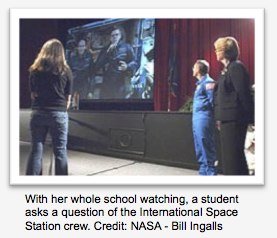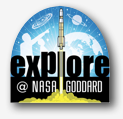Escape the heat of the waning days of summer for an evening of sky watching. The Perseid meteor shower peaks on the night of August 11 through the morning of August 12. Perseid rates can get as high as 100 per hour, with many fireballs visible in the night sky. A waning crescent moon will interfere slightly with this year’s show, but viewing should definitely be worth a look!
Cloud covering the night sky in your area? Not a problem. On the night of Aug. 11-12, astronomer Bill Cooke and his team from the Meteoroid Environment Office at NASA’s Marshall Space Flight Center will answer your questions about the 2012 Perseid meteor shower via an “Up All Night” live chat. To join the chat, simply head over to this page and log in. The chat experts will be available to answer questions between the hours of 11 p.m. – 3 a.m. EDT, beginning the evening of Aug. 11 and continuing into the morning of Aug. 12.
Link to the NES Virtual Campus home page.

 During Expeditions 31 and 32, crew members aboard the International Space Station will participate in downlinks. Downlinks are approximately 20 minutes in length and allow students and educators to interact with astronauts through a question and answer session. Downlinks afford education audiences the opportunity to learn firsthand from astronauts what it is like to live and work in space. Downlinks are broadcast live on NASA TV and are streamed on the NASA website. Because of the nature of human spaceflight, organizations must demonstrate the flexibility to accommodate changes in downlink dates and times.
During Expeditions 31 and 32, crew members aboard the International Space Station will participate in downlinks. Downlinks are approximately 20 minutes in length and allow students and educators to interact with astronauts through a question and answer session. Downlinks afford education audiences the opportunity to learn firsthand from astronauts what it is like to live and work in space. Downlinks are broadcast live on NASA TV and are streamed on the NASA website. Because of the nature of human spaceflight, organizations must demonstrate the flexibility to accommodate changes in downlink dates and times. In a special outreach titled Space Farm 7, seven of the nation’s top agritourism farms have been selected to celebrate and honor the U.S. space program in collaboration with NASA this fall. Each farm has planted corn mazes that will feature designs celebrating NASA’s achievements and progress in space. An increasingly popular phenomenon of crop circle-type creations, each of the seven corn mazes will open this fall to challenge and delight visitors.
In a special outreach titled Space Farm 7, seven of the nation’s top agritourism farms have been selected to celebrate and honor the U.S. space program in collaboration with NASA this fall. Each farm has planted corn mazes that will feature designs celebrating NASA’s achievements and progress in space. An increasingly popular phenomenon of crop circle-type creations, each of the seven corn mazes will open this fall to challenge and delight visitors.

 Students and their families explored a variety of science stations. They looked through large telescopes set up by members of the Greater New Haven Astronomical Society; viewed lunar craters and the moons of Jupiter; and learned about constellations by viewing a planetarium show inside a portable planetarium.
Students and their families explored a variety of science stations. They looked through large telescopes set up by members of the Greater New Haven Astronomical Society; viewed lunar craters and the moons of Jupiter; and learned about constellations by viewing a planetarium show inside a portable planetarium.  The lesson from the NASA Explorer Schools module Lunar Nautics: Lunar Base Supply Egg Drop makes a great family night activity. Students and their parents design and construct a package for the raw egg payload. The package should allow the raw egg payload to be recovered unharmed (both the shell and yolk should be intact) when dropped from a second story (height of at least 9.144 meters).
The lesson from the NASA Explorer Schools module Lunar Nautics: Lunar Base Supply Egg Drop makes a great family night activity. Students and their parents design and construct a package for the raw egg payload. The package should allow the raw egg payload to be recovered unharmed (both the shell and yolk should be intact) when dropped from a second story (height of at least 9.144 meters).